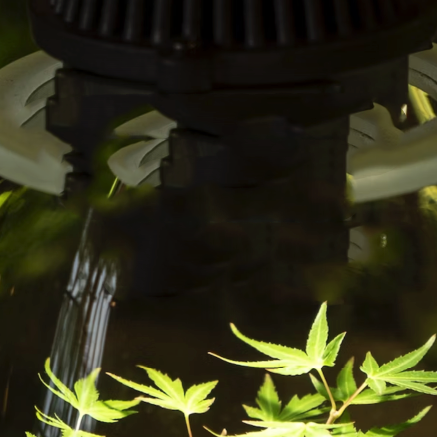Human hand and mesh network - https://www.lightrail3.com/media/
After a bit of a break from our LED experiment, we are now back with some results of our test with the Prakasa 300 Watt LED grow light.
An overview of our testing technique is outlined in the earlier posts in this series.
The Prakasa lamp was suspended centrally in a 1m x 1m grow tent, similar to that which would be used by most growers who would be growing with a similarly rated HPS lamp.
The light intensity was measured at each grid cross-section point within the grid and around the edges. In this way, the spread of the light across the surface of a grow space could be measured and then plotted.
The measurements were taken at 2 different heights.
The first height (36cm from the lamp) was decided upon as this was the height at which central measurement was 1000µmol, which is a good light intensity for excellent plant growth. The rest of the measurements were then taken at this same height at each point on the grid.
Plotted on a 3D graph, the results look like this:
It would seem to be fairly obvious, even with just a casual glance, that the grow lamp is only producing a high intensity of light directly underneath the centre of it. This was a little surprising to me because the impression I got from just using my eyes was that the light intensity seemed to be much more even than this.
In fact, I thought I must have made some kind of error in my measurement taking. So much so that I ended up rechecking my results. However, I had made no mistakes, the results really were as shown in the above graph.
To decide on the next height, I experimented a little to try to find a good balance between spread and intensity. It was my intention to find that ideal height that gave enough intensity at the centre that would give good growth, while still illuminating the edges adequately.
I found that the best height that achieved the most even spread was 43cm.
At 43cm, the graph does look somewhat flatter. The peak in the middle is most definitely still there, however, the average spread across the tent is much better.
I would have to say, that despite my hopes for this lamp, the results are somewhat disappointing.
I spent quite some time testing to see if I could find a height at which the light intensity at the edges of the tent was satisfactory. In this 1m x 1m tent the maximum intensity I could find at any point the edges was 270µmol. This measurement was actually found at the 43cm height in the graph shown above.
270µmol would not generally be considered to be a fantastic intensity for excellent plant growth. It may be just about adequate for young or vegging plants. However, during the flowering/fruiting period you are going to need at least 2 to 3 times that for a really nice size crop.
Remember, this lamp consumes 300 Watts, and costs £300 or thereabouts. I seriously expected it to have a much better spread. The intensity of light directly underneath is fine but anywhere else in tent there is a definite shortcoming.
At the moment, I have not completed my experiments with other types of light source. In the following articles in this series I will be testing and measuring the following lights and producing similar graphs for comparison:
A 250 Watt CFL
216 Watt T5 Maxibright LightWave
300 Watt Gavita Plasma
250 Watt and 400 Watt HPS
250 Watt and 400 Watt MH
It will be interesting to see how the Prakasa lamp stands up to comparison with these other types of light source. In particular, I will be very interested to find out how the spread of light stands up against the standard growers favourites: the Maxibright LightWave and HPS lights.
As always, the proof is in the pudding, and while I am spending time testing the other types of lamp, I shall also be growing an actual real, live plant under the Prakasa to see just what can be produced.
Watch this space.....!

